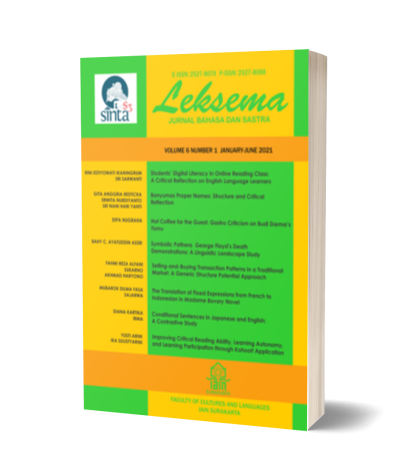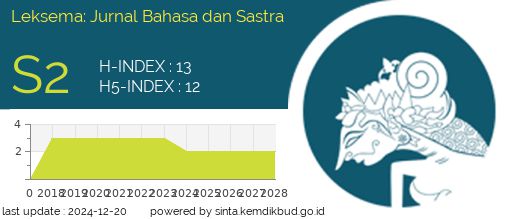STYLISTIC STUDY OF WAROK'S SPELLS OF PANARAGAN JAVANESE ETHNIC (KAJIAN STILISTIKA TERHADAP MANTRA WAROK ETNIK JAWA PANARAGAN)
DOI:
https://doi.org/10.22515/ljbs.v1i2.179Keywords:
ethnolinguistics, Warok curse, Panaragan Javanese ethnicsAbstract
This research aims at describing spell (mantra) language of Ponorogo’s warok  on the aspect of language style, diction, and rhyme. This is a field research with Ponorogo’s warok as the informant. It applies observing, listening and note-taking technique. The data are analyzed using descriptive qualitative approach. The results of the research show that the spells of warok have characteristics of aliteration, assonance, polysidenton, asidenton, antonomatia, metaphor, hyperbole, pararhyme, and repetition language style, including anadiplosis, simploke, mesodiplosis, epizeuksis, tautotes, epistrofa, anafora. Meanwhile, on the aspect of diction, they cover connotation, denotation, religious symbols, synonyms, antonyms, and spirits. In addition, the taste of spell rhyme is resulted from some factors, such as sound repetition and connection between lines in a couplet, all that has functions to add artistic values to the spells so that they produce harmonious and synchronous effects of sounds.
Downloads
References
Junus, Umar. 1989. Stilistika Suatu Pengantar. Kuala lumpur: Dewan Bahasa dan Pustaka
Kadarisman, Effendi A. 2009. Mengurai Bahasa Menyibak Budaya. Malang:Universitas Negeri Malang.
Spradly, James P. 1997. The Etnography Interview. Penerjemah Misbah Zulfa Elizabet dengan Judul Metode Etnografi. Yogyakarta:Tiara Wacana
Ratna, Nyoman Kutha. 2009. Stilistika: Kajian Puitika, Bahasa, Sastra, dan Budaya. Yogyakarta:Pustaka Pelajar.
Santosa, Riyadi. 2012. Metode Penelitian Kualitatif Kebahasaan. Surakarta: Fakultas Sastra dan Seni Rupa.
Sutedjo dan Sumarlam. 2008. Jurnalistik Plus 1 Kiat Merentas Media Dengan Ceria. Yogyakarta: Nadi Pustaka.
Downloads
Published
Issue
Section
License
The copyright of the received article shall be assigned to the publisher of the journal. The intended copyright includes the right to publish the article in various forms (including reprints). The journal maintains the publishing rights to published articles.
In line with the license, the authors and users (readers or other researchers) are allowed to share and adapt the material only for non-commercial purposes. In addition, the material must be given appropriate credit, provided with a link to the license, and indicated if changes were made. If authors remix, transform or build upon the material, authors must distribute their contributions under the same license as the original.






